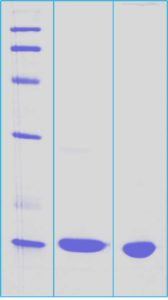Cystatin C Human NATIVE, Human Urine
Cystatin C is a non-glycosilated basic single-chain protein consisting of 120 amino acids with a molecular weight of 13.36 kDa and is characterized by two disulfide bonds in the carboxy-terminal region. It belongs to the cystatins superfamilly which inactivates lysosomal cysteine proteinases, e.g. cathepsin B, H,.K, L and S. Imbalance between Cystatin C and cysteine proteinases is associated with inflammation, renal failure, cancer, Alzheimer’s disease, multiple sclerosis and hereditary Cystatin C amyloid angiopathy. Its increased level has been found in patients with autoimune diseases, with colorectal tumors and in patients on dyalisis. Serum Cystatin C seems to be better marker of glomerular filtration rate than creatinine. On the other hand, low concentration of Cystatin C presents a risk factor for secondary cardiovascular events.
Type
Native
Description
Native protein isolated from human urine.
Source
Human urine
Purity
Purity as determined by densitometric image analysis: >96%
SDS-PAGE Gel
12% SDS-PAGE separation of Human Cystatin C
1. M.W. marker – 14, 21, 31, 45, 66, 97 kDa
2. reduced and heated sample, 5μg/lane
3. non-reduced and non-heated sample, 5μg/lane

Endotoxin
< 1.0 EU/ug
Formulation
Filtered (0,4 μm)) and lyophilised from 0.6 mg/mL in 20mM NH4HCO3 with traces of buffer salts.
Reconstitution
Add 20mM NH4HCO3 to prepare a working stock solution of approximately 0.5 mg/mL. Product is not sterile! Please filter the product by an appropriate sterile filter before using it in the cell culture.
Applications
Western blotting, ELISA
Shipping
At ambient temperature. Upon receipt, store the product at the temperature recommended below.
Storage/Expiration
Store the lyophilized protein at –80 °C. Lyophilized protein remains stable until the expiry date when stored at –80 °C. Aliquot reconstituted protein to avoid repeated freezing/thawing cycles and store at –80 °C for long term storage. Reconstituted protein can be stored at 4 °C for a week.
Quality Control Test
BCA to determine quantity of the protein.
SDS PAGE to determine purity of the protein.
LAL to determine quantity of endotoxin.
– Abdul-Hussien H, Soekhoe RG, Weber E, von der Thusen JH, Kleemann R, Mulder A, van Bockel JH, Hanemaaijer R, Lindeman JH. Collagen degradation in the abdominal aneurysm: a conspiracy of matrix metalloproteinase and cysteine collagenases. Am J Pathol. 2007 Mar;170 (3):809-17
– Kaseda R, Iino N, Hosojima M, Takeda T, Hosaka K, Kobayashi A, Yamamoto K, Suzuki A, Kasai A, Suzuki Y, Gejyo F, Saito A. Megalin-mediated endocytosis of cystatin C in proximal tubule cells. Biochem Biophys Res Commun . Jun 15;357(4):1130-4 (2007)

